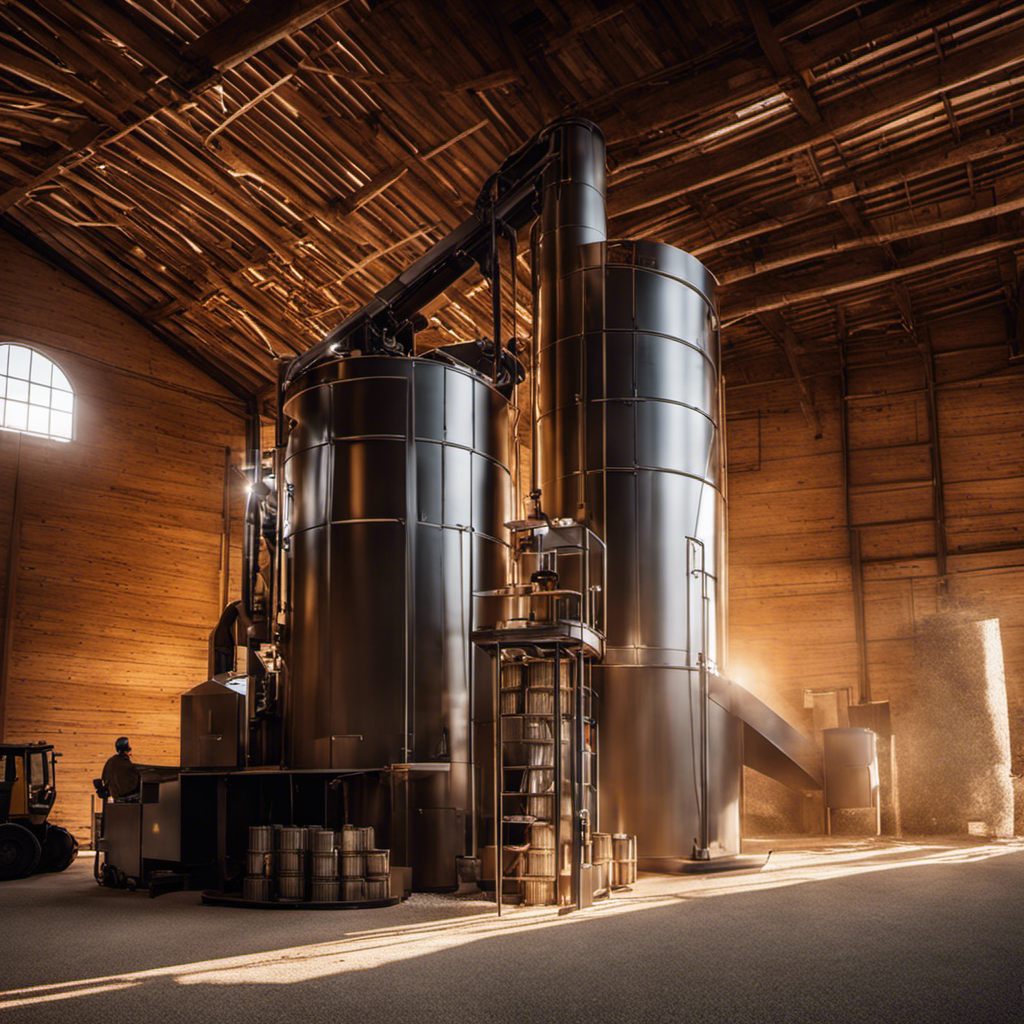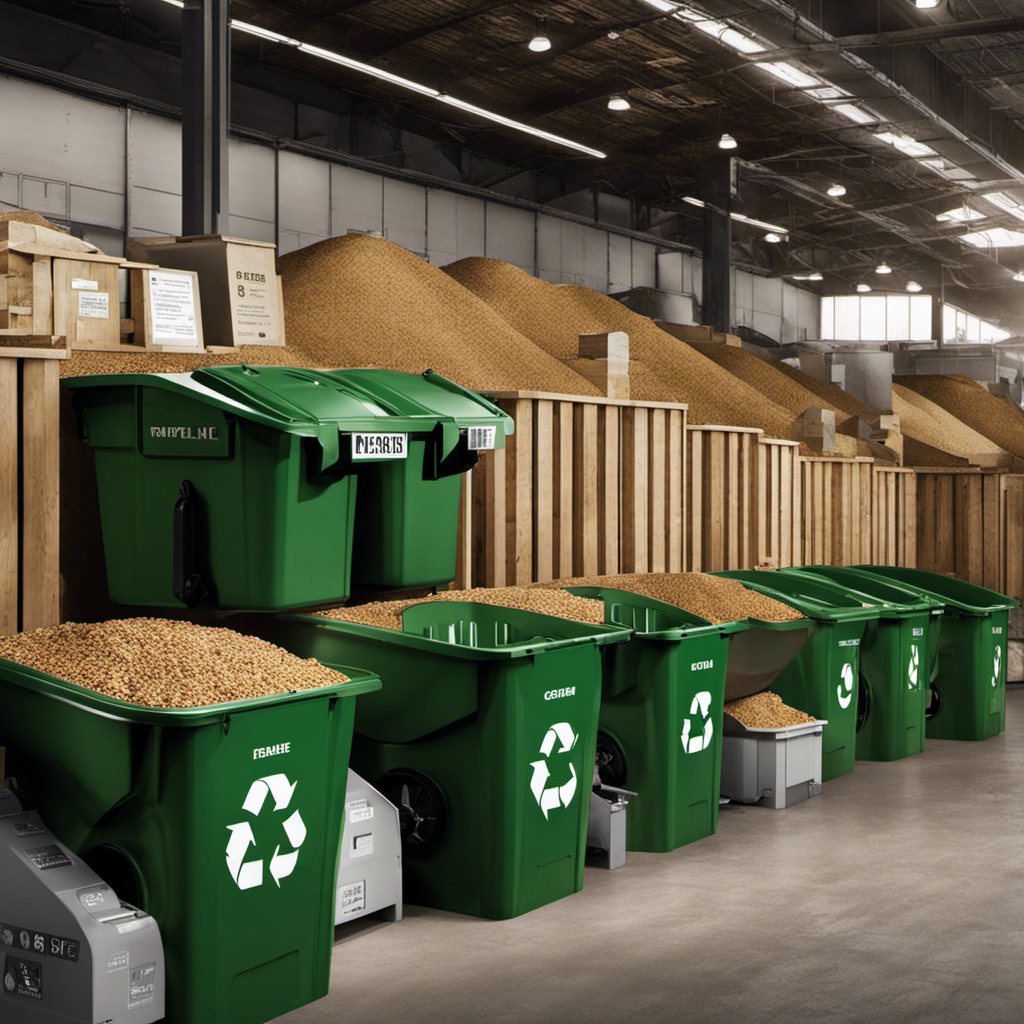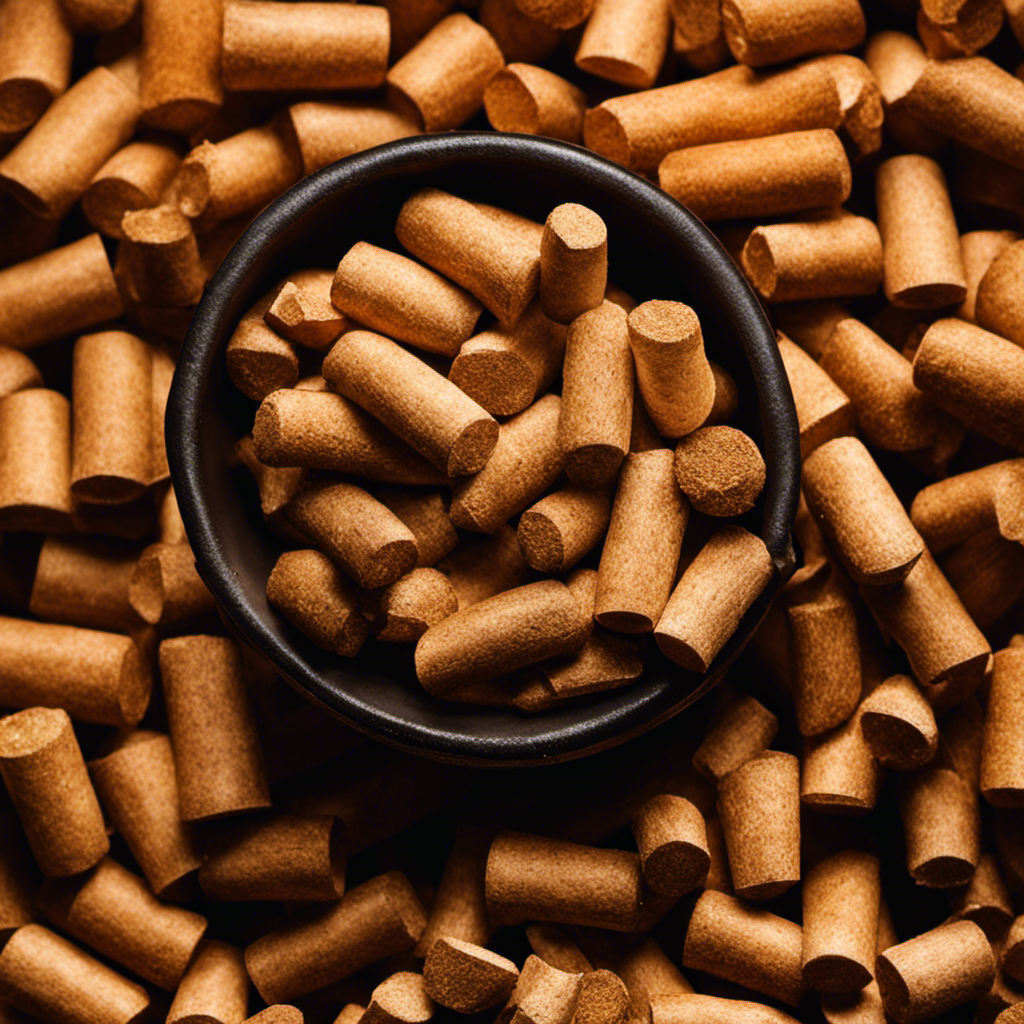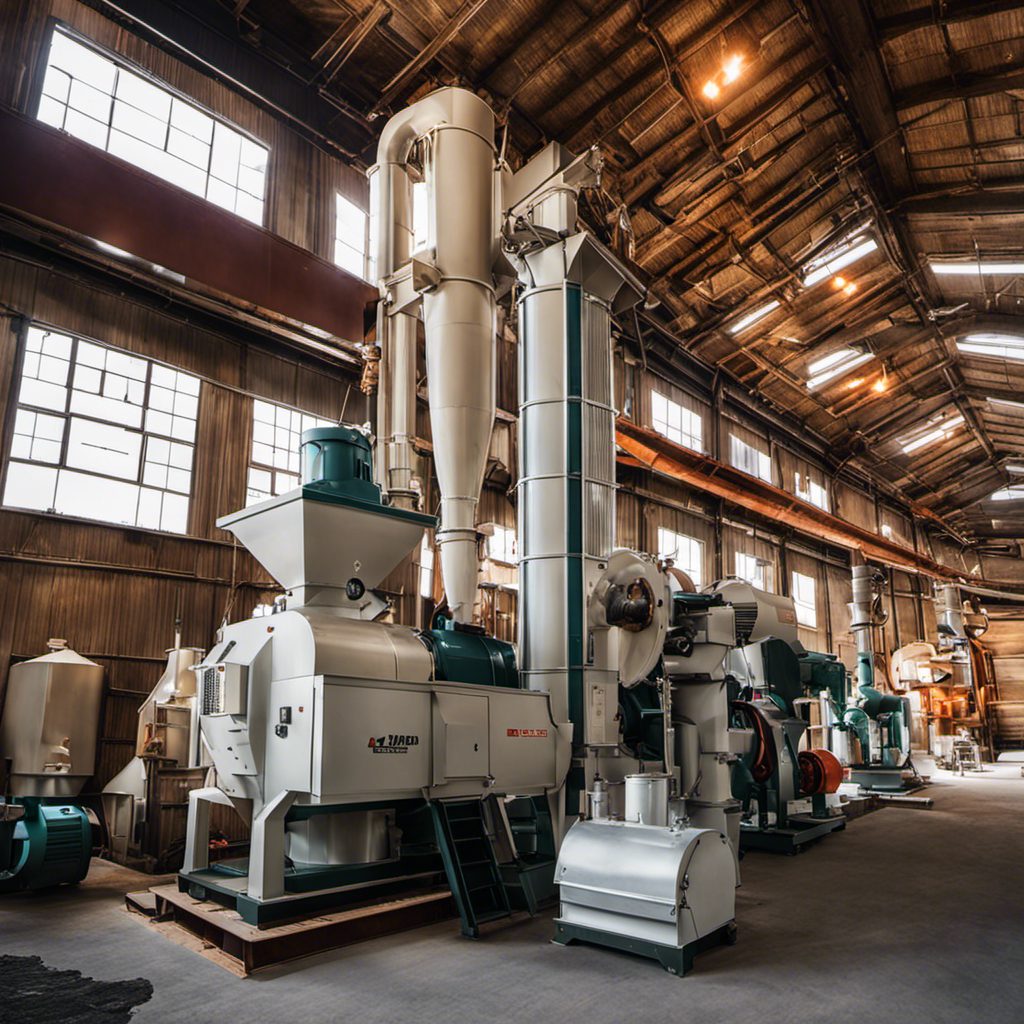As a passionate DIY enthusiast, I’ve refined the skill of turning wood into high-quality pellets. Come along with me as I demonstrate the process of creating wood pellets and help you discover the inner carpenter inside you.
From identifying the perfect wood types to mastering the pelletizing process, I’ll guide you through every step. With the right equipment and a little know-how, you’ll be producing your own eco-friendly fuel in no time.
Let’s dive into the world of wood pellet production and unlock your potential.
Key Takeaways
- Types of wood suitable for pellet making
- Equipment and tools needed for wood pellet production
- Proper grinding techniques for preparing the wood material
- The pelletizing process: from raw material to finished pellets
Types of Wood Suitable for Pellet Making
There are several types of wood that are suitable for pellet making. In the wood pellet market, trends show a growing demand for renewable energy sources. Wood pellets have gained popularity due to their environmental benefits, as they are a clean and sustainable fuel alternative.
When it comes to choosing the right wood for pellet production, hardwoods such as oak, maple, and birch are commonly used. These woods have a high energy content and produce pellets with excellent heat output. Softwoods like pine and fir are also suitable options, as they are readily available and cost-effective. However, they have a lower energy content compared to hardwoods.
Transitioning to the next section on equipment and tools needed for wood pellet production, it is crucial to have the right set of tools to ensure efficient and effective pellet making.
Equipment and Tools Needed for Wood Pellet Production
To produce wood pellets, you’ll need some essential equipment and tools. Wood pellet production methods vary, but the basic equipment remains the same.
Firstly, you’ll need a wood chipper to break down the raw wood material into smaller pieces. This is followed by a hammer mill, which further reduces the size of the wood chips into a finer texture.
Next, a dryer is used to remove moisture from the wood material, ensuring optimal pellet production. Afterward, a pellet mill is employed to compress the dried wood particles into pellet form. Finally, a cooler is used to reduce the temperature of the newly formed pellets.
The benefits of using wood pellets include their renewable nature, low emissions, and high energy density.
Now, let’s move on to preparing the wood material for pellet making by selecting the appropriate size and quality.
Preparing the Wood Material for Pellet Making
Choose the appropriate size and quality of the raw material to prepare it for pellet production. Wood preparation is a crucial step in making high-quality pellets. Here are three key aspects to consider when preparing the wood material:
-
Debarking logs: Before processing the wood, it’s important to remove the bark. This not only improves the quality of the pellets but also prevents contaminants from entering the production process.
-
Size reduction: The raw material needs to be reduced to a suitable size for pelletizing. This can be achieved through processes such as chipping or grinding, ensuring that the wood is in small, uniform pieces.
-
Drying: The moisture content of the wood must be reduced to an optimal level. This is typically done by air drying or using specialized drying equipment. Properly dried wood ensures efficient pellet production and prevents mold or degradation.
The Pelletizing Process: From Raw Material to Finished Pellets
Once the wood material has been properly prepared, it’s time to move on to the pelletizing process. This is where the raw material is transformed into high-quality wood pellets.
Two crucial factors in this process are moisture control and pelletizing temperature. Maintaining the right moisture content is essential for producing durable pellets. Too much moisture can lead to clumping and poor pellet quality, while insufficient moisture can result in weak pellets that crumble easily.
Additionally, the pelletizing temperature plays a crucial role in ensuring the pellets are formed properly. It should be set at the optimal range to allow the lignin in the wood to bind the particles together.
Tips for Ensuring High-Quality Wood Pellets
When it comes to producing high-quality wood pellets, two key factors that cannot be overlooked are moisture content and proper grinding techniques.
Maintaining the correct moisture content in the raw materials is crucial for achieving optimal pelletization, as it affects the density and durability of the pellets.
Additionally, using the proper grinding techniques ensures that the raw materials are evenly and finely ground, resulting in pellets with consistent size and shape.
Moisture Content Importance
The moisture content of the wood pellets is crucial for their quality and efficiency. Maintaining the right moisture level ensures that the pellets burn efficiently and produce maximum heat.
Here are three key points about the role of drying in wood pellet production and how to measure and control moisture content:
-
Drying process: Before pelletizing, the wood material must be dried to remove excess moisture. This is typically done using a dryer or kiln to reduce the moisture content to the optimal range.
-
Moisture measurement: Moisture content can be measured using a moisture meter. This tool allows producers to accurately determine the moisture levels of the wood material and adjust the drying process accordingly.
-
Moisture control: Controlling moisture content is essential for consistent pellet quality. By monitoring and adjusting the drying process, producers can ensure that the moisture content remains within the desired range.
Proper moisture content is just the first step in producing high-quality wood pellets. The next section will discuss the importance of proper grinding techniques in pellet production.
Proper Grinding Techniques
Proper grinding techniques play a crucial role in ensuring the quality and efficiency of wood pellet production. The size of the wood pellets is directly influenced by the grinding process. To achieve the desired pellet size, it is important to adjust the grinding equipment properly, considering factors such as the type of wood and the desired end product.
The wood should be finely ground to a consistent size that allows for optimal combustion and pellet formation. Additionally, the use of a pellet binder during the grinding process can enhance pellet durability and reduce dustiness. These techniques not only contribute to the overall quality of the wood pellets but also optimize the production process.
Now, let’s delve into the best practices and considerations when it comes to storing and using wood pellets.
Storing and Using Wood Pellets: Best Practices and Considerations
To effectively store and use wood pellets, you should always keep them in a dry environment. Moisture can cause the pellets to degrade and lose their efficiency. Here are three important considerations for storing and using wood pellets:
-
Storage options: It is crucial to store wood pellets in airtight containers or bags to prevent moisture from seeping in. Look for storage options that are specifically designed for pellet storage, such as pellet bins or sealed containers. Additionally, keep the pellets away from direct sunlight and extreme temperatures to maintain their quality.
-
Pellet stove maintenance: Regular maintenance of your pellet stove is essential to ensure optimal performance and efficiency. Clean the stove regularly, including the burn pot, ash trap, and exhaust vents. Check the condition of the gaskets and replace them if necessary. It is also important to inspect and clean the chimney to prevent any blockages that could affect the stove’s performance.
-
Proper handling: When using wood pellets, it is important to handle them carefully to prevent breakage or damage. Avoid dropping the bags or exposing them to excessive vibrations. Store the pellets in a location that is easily accessible for refilling the stove but away from any potential hazards or flammable materials.
Frequently Asked Questions
What Is the Average Cost of Wood Pellets?
The average cost of wood pellets varies depending on factors such as location and availability. It is important to consider these factors when purchasing wood pellets to ensure you are getting the best price for your needs.
Can Wood Pellets Be Used in All Types of Pellet Stoves?
Yes, wood pellets can be used in all types of pellet stoves. They are suitable for both freestanding and insert pellet stoves. Using wood pellets offers several benefits, such as high heat output and efficient combustion.
How Long Do Wood Pellets Typically Last When Used for Heating Purposes?
Wood pellets typically last for several hours when used for heating purposes. The longevity of the pellets depends on factors such as the size of the stove and the efficiency of combustion.
Are There Any Environmental Benefits to Using Wood Pellets as a Heating Source?
Using wood pellets as a heating source brings environmental benefits. They promote environmental sustainability by reducing carbon emissions. The process of making wood pellets is crucial in ensuring their eco-friendly nature.
Can Wood Pellets Be Used for Cooking or Grilling Purposes?
Yes, wood pellets can be used for cooking and grilling purposes. They provide a consistent and even heat, making them great for smoking, roasting, and grilling. Plus, they add a delicious smoky flavor to your food.
Can Making Wood Pellets Lead to the Formation of Wood Pellet Clinkers?
Making wood pellets can lead to the formation of wood pellet clinkers, which are hardened masses of ash and unburned material. These clinkers can clog up your pellet stove’s burn pot and affect its efficiency. It’s important to understand the wood pellet clinker definition and how to prevent their formation.
Conclusion
In conclusion, making wood pellets is a rewarding and sustainable process. By selecting the right type of wood and using the proper equipment, you can transform raw material into high-quality pellets.
It’s like crafting a masterpiece, where each step is crucial in creating a final product that is efficient and clean-burning. By following best practices for storage and use, you can enjoy the warmth and comfort of wood pellets while reducing your carbon footprint.
So, let’s get started and turn wood into pellets, like an artist turning a blank canvas into a vibrant painting.
Growing up surrounded by the vast beauty of nature, Sierra was always drawn to the call of the wild. While others sought the comfort of the familiar, she ventured out, embracing the unpredictable and finding stories in the heartbeat of nature.
At the epicenter of every remarkable venture lies a dynamic team—a fusion of diverse talents, visions, and passions. The essence of Best Small Wood Stoves is crafted and refined by such a trio: Sierra, Logan, and Terra. Their collective expertise has transformed the platform into a leading authority on small wood stoves, radiating warmth and knowledge in equal measure.











